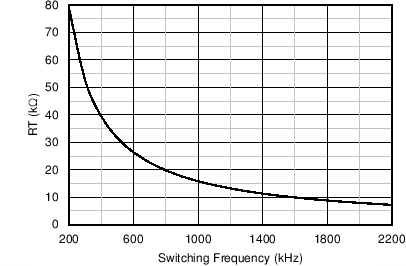JAJSIE0G November 2019 – November 2024 LM63635-Q1
PRODUCTION DATA
- 1
- 1 特長
- 2 アプリケーション
- 3 概要
- 4 Device Comparison Table
- 5 Pin Configuration and Functions
- 6 Specifications
- 7 Detailed Description
- 8 Application and Implementation
- 9 Device and Documentation Support
- 10Revision History
- 11Mechanical, Packaging, and Orderable Information
パッケージ・オプション
メカニカル・データ(パッケージ|ピン)
サーマルパッド・メカニカル・データ
発注情報
7.3.3 Switching Frequency Selection
The switching frequency is set by the condition of the RT input. The condition of this input is tested when the device is first enabled. After the converter is running, the switching frequency selection is fixed and cannot be changed until the next power-on cycle. Table 7-3 shows the selection programming. In the adjustable frequency mode, the switching frequency can be set between 250 kHz and 2200 kHz by proper selection of the value of RT. The curve in Figure 7-1 indicates the required resistor value for RT to set a desired switching frequency. TI does not recommend that this input be allowed to float; the switching action ceases with no generated output voltage under this condition.
where
- RT = value of RT timing resistor in kΩ
- ƒSW = switching frequency in kHz
| RT INPUT | SWITCHING FREQUENCY |
|---|---|
| VCC | 400 kHz |
| AGND | 2100 kHz |
| RT to AGND | Adjustable according to RT value |
| Float (not recommended) | No switching |
 Figure 7-1 Switching Frequency versus RT
Figure 7-1 Switching Frequency versus RT